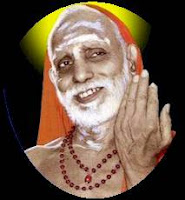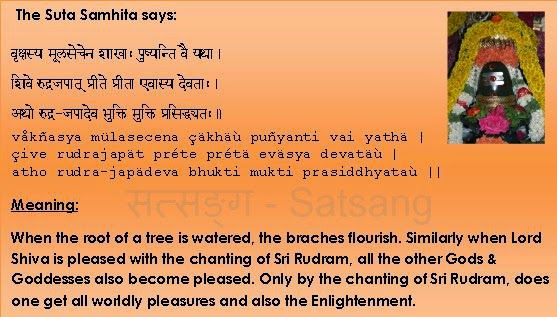When I continued reading, the term 'Urakam' came up. At once he asked me to stop reading.
"Where are we now?"
"Kanchipuram."
"This place?"
"Sivakanchi, periya (bigger) Kanchipuram."
He was not satisfied with my reply. Some people were standing behind me. An old dampati (husband and wife) among them joined their palms to PeriyavaaL. "Ask them what their place (of living) is." I asked them.
Old man: Palakkad.
PeriyavaaL's face brightened. "Ask him if the Amma nearby him is his samsAram (wife)."
I asked. He said, "Yes."
PeriyavaaL's question to them: "Is there a Kamakshi temple near your place?"
Old man: I don't know.
AmmaaL: Seems Periyavaa asks about 'Urakam Kamakshi'...
"Ask that AmmaaL to come to the front."
She came.
"You have gone there, that temple?"
"I have gone. They would have portrayed AmbaaL on a piece of cloth."
"Alright, go and come back." Periyavaa gave her his anugraha with a smile.
Then he told me this story:
"The Kamakshi here was very prasiddha (celebrated, famous) in the olden days. She remained dazzling in her sannidhi. One day a Malayala Namboothiri came here to have her darshan. He stood amazed looking at AmbaaL. It seemed he was a sAktA (Goddess worshipper). The Namboothiris would come to the temple with a palm leaf umbrella (thAzham kudai). You have seen a palm leaf umbrella? (I said 'yes'). It can't be collapsed. He sat in the AmbaaL Sannidhi, and by his japam did AkarSaNaM (attract) of a kalA (part) of AmbaaL on that umbrella and went away to Palakkad. His village was nearby. He did AvAhanam (invoked) of AmbaaL by transferring her presence from the umbrella to a cloth on which he had drawn a portrait of her figure. They named their village with the same name as this place where Kamakshi is residing. Kanchipuram has another name Urakam."
He narrated this tasteful history with his characteristic natural fluency.
---------
About Urakam Ammathiruvadi Temple
The Devi temple situated at Urakam, is one amongst the major 108 Durga temples, popularly called as “Ammathiruvadi temple”.
According to the Kerala folklore, Poomulli Namboothiri (also sometimes referred to as Thiruvalayannur Bhattathiri) founded Ammathiruvadi temple about 700–1000 years ago. Legend has it that , due to the atrocities and calamities happening within the Desham (city), elders suggested three prominent members from the community, viz, Valaya Bhattathiri, Kadalayil Namboothiri and then Komarathu Menon to travel to Kancheepuram and pray to goddess Kanchi Kamakshi to please her and bring favourable solutions to ward off the evil effects happening that time. They all went and pleased with their prayers, happy with the devotion, Devi agreed to come with them to Urakam. Accordingly, Kanchi Kamakshi decided to come to Kerala on the palm leaf umbrella of Poomulli (Valayannur) Namboothiri. He reached home and placed the umbrella on the floor of his house. After a short sleep, he came back and found that he was unable to take back the umbrella from the place where he kept. It was heavily grounded to the floor. Later, it was confirmed that Kanchi Kamakshi was residing on that umbrella. The goddess came in Namboothiri’s dreams that night and let him know that he was supposed to build a temple for the goddess, leave Urakam and move towards North. She also let him know that he was to find an idol in a well far away and reinstate the goddess from the umbrella onto that idol. Namboothiri did as the goddess wished. He built the temple, and after a short period of administration of the temple matters by the Poomulli family, he left all that he owned to the temple, and gave the administration to the Maharaja of Cochin. From then, the goddess has been known as the Ammathiruvadi.
Later on the temple administration was transferred to Cochin Devaswam Board, who takes care of it even now. Urakam Ammathiruvadi temple is an integral part of the 1400 year old Arattuppuzha pooram festival. Arrattuppuzha pooram is called as Deva Mela, where all the gods and goddesses assemble together in the presence of Thriprayar Thevar (Sri Rama). According to the old customs continued by the family of the king of Cochin and then subsequently by the Kerala State, whenever, Ammathiruvadi travels outside the temple, i.e for Pooram or other festivals, she is supposed to be greeted with official “Guard of Honour” by the police.
Stories passed on from elders, also say that in those days, the idol installed by Poomulli Namboothiri was originally the Devi idol worshipped by Sri Rama before he went to war with Ravana. There are several historic connections, one gets to see in places nearer to Oorakam, supporting the claim that the village was part of ancient Hindu history. Due to the same connections, this village and all the adjacent villages remain divine and prosperous throughout. Agricultural and other activities always flourish here.
It is also said that one family close to the temple became so devoted to the Devi that she was pleased with their bhakthi and from then on, the eldest member of this family – Vazhappilly – became the guard of Ammathiruvadi and wherever she went, she was accompanied by this member. This continues even now.
Since she came to Urakam on an umbrella made of palm leaf, whenever Ammathiruvadi’s idol is carried out, it will be accompanied by a person carrying an umbrella made of palm leaf.
Urakam Ammathiruvadi is considered as Goddess Lakshmi. However, devotees can also worship the Devi as Durga as well as Saraswathi and get the blessings. On the top of the Dhwaja Stambha (Kodimaram) is the statue of a lion which signifies that Devi is alsoworshipped as Mahishasuramardini. There are two more deities (upadevas) inside the inner courtyard, they are Lord Sastha and Lord Ganesha. It is believed that the presence of Lord Subrahmania is there in the temple. Nagaraja is there in the south east corner of the compound. It is believed that presence of Kodungallur Bhagawathy is there on the Eastern Gopuram. The Devi being a Kanyaka (virgin), no fragrant flowers are used for the pooja. In this temple only Veda Mantras are used for the poojas. Kaartika Nakshatra in the Malayalam month of Vrischika is the birth day of Devi. On that day, there will be number of programmes including Annadaanam. Also on every Kaarthika star day, there will be Naama japam and annadaana as offerings by the devotees.
Courtesy:
Thanjavur SanthanaRaman,
Maha PeriyavaL - Darisana AnubhavangaL vol. 1, pages 41-65, Vanathi Padhippaham,
http://www.templeadvisor.com/temples-in-india/hindu-temples/urakam-ammathiruvadi-temple.























.jpg)






